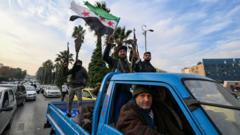Syrian rebel forces celebrated a major victory on Sunday as they entered Damascus with minimal resistance, amid reports that President Bashar al-Assad has fled the country. This developments marks a dramatic turn in a brutal civil war that has lasted for over a decade, claiming hundreds of thousands of lives and displacing millions. Prime Minister Mohammed al-Jalali has expressed readiness to support continuity in governance, potentially suggesting a transition in leadership.
Only days prior, the Islamist militant group Hayat Tahrir al-Sham (HTS) spearheaded a significant offensive in Northwest Syria. The rebels quickly captured Aleppo, Syria's second-largest city, and advanced towards the capital as the Syrian military appeared to collapse with little resistance.
The roots of the Syrian conflict stem from a peaceful pro-democracy movement that began in 2011, which rapidly escalated into a full-blown civil war drawing in various international actors. With more than half a million fatalities and approximately 12 million displaced, the effects of this conflict have been devastating.
Prior to the recent offensive, the war had reached a perceived stalemate, with Assad's forces regaining control over most urban areas, largely due to support from Russia and Iran. However, significant portions of the country, especially in the north and east, remained beyond government control, held by Kurdish-led forces backed by the U.S.
The province of Idlib—home to over four million displaced individuals—has seen HTS consolidate power by stamping out rival factions, including al-Qaeda remnants and Islamic State cells. HTS claimed their recent assault was a defensive response to escalating government aggression in the region.
After years of relative stability following a Russian-Turkish brokered ceasefire in 2020, HTS, sensing an opportunity amid government vulnerabilities exacerbated by ongoing regional conflicts and sanctions, launched their offensive. Within days, they secured significant territory including Hama, and subsequently announced the capture of Homs, leading them toward Damascus.
On Sunday, the rebels declared they had entered the capital, also claiming the release of detainees from Saydnaya prison—infamous for holding and executing opposition supporters. They proclaimed the end of Assad’s regime, emphasizing a potential new era for Syria.
As the situation unfolded, senior military officers indicated that Assad had departed the capital for an undetermined location. Prime Minister al-Jalali, in a video statement, showed a willingness to collaborate with any leadership deemed chosen by the people.
Global reactions have poured in, with the White House stating that President Biden and his team are closely monitoring the unfolding events and maintaining communication with regional allies. The future of governance in Syria remains uncertain as various factions jockey for power in the aftermath of this pivotal moment in the civil war.




















